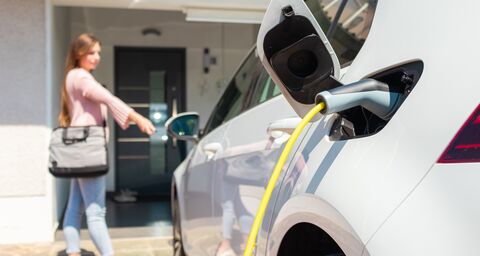
EV batteries – their makeup, features and future
EV batteries play a key role in the expansion of electromobility. In the context of the energy transition and climate protection, electric cars are becoming increasingly important and are expected to make a significant contribution to reducing carbon emissions in the transportation sector in the future.
E-mobility and the importance of the e-battery
Electromobility is a decisive step towards a greener future. At the end of 2024, more than 203,000 electric cars had already been registered in Switzerland – a market share of 4.2 percent. The number is growing steadily, and by 2035 more than 2 million electric vehicles are expected to be on Swiss roads.
However, some progress is still needed in order to achieve this goal. It is particularly important to further increase the acceptance of electric cars and create attractive incentives so that more and more people choose an electric car.
In addition to financial and tax benefits, technology plays a key role. A key element is the battery, which is considered to be the most expensive component of an electric vehicle.
Everyone knows from smartphones and other devices that batteries lose performance over time. The same applies to electric cars – the battery plays a key role in determining the range. For many people, this is a decisive factor, because if you use your car every day or drive long distances, you need a reliable and powerful battery. In addition, charging takes considerably longer than refueling an internal combustion engine.
In order for charging to be optimally integrated into everyday life, not only will it take high-performance batteries, but also constant technological advances.
These are the EV batteries that are currently available
There are different kinds of batteries that are used for EVs. The most common is the lithium-ion battery. But there are also lithium-polymer batteries and nickel-metal hydride batteries. These types of batteries mainly differ with regard to performance, capacity, lifespan and cost.
- Lithium-ion batteries offer clear advantages over other electric car batteries. They have a higher energy density and therefore store more energy with the same size and weight. And this translates into a greater range. Their lifespan is also longer, and they can undergo a larger number of charging cycles in an electric car before they need to be replaced. Lithium polymer batteries follow a very similar principle, but the use of polymer plastic ensures that the battery is very flexible in shape.
- Nickel-metal hydride batteries are less prone to overheating, so they are considered to be safer to use. However, they cannot transfer all the energy to the engine, which significantly reduces efficiency and has prevented a major breakthrough so far.
- Lead-acid batteries are the oldest and simplest type of batteries for electric vehicles. But since they have very low energy density and very little capacity, they’re not well suited to the task.
Due to their high energy density and capacity and long lifespan, lithium-ion batteries are the preferred battery technology for EVs. In the long run, however, solid-state batteries could very well be a viable alternative. The problem is that the technology is not market ready.
The most commonly used batteries are Lithium batteries
Electric car batteries have evolved in recent years. Lithium-ion technology has established itself on the market and is installed in most models.
- Build: A lithium-ion battery consists of several components. The most important components are anode and cathode, the electrolyte and the separator foil. Anodes are generally made of graphite, while cathodes are a mix of lithium compounds such as lithium cobalt oxide or lithium iron phosphate. The electrolyte is a fluid or a gel from an ionic bond which enables the ions to flow between the anodes and cathodes. The separator film is a thin layer placed between the anode and cathode to prevent short circuiting.
- Operating principle: When the battery is charged, lithium ions move through the electrolytes from the cathode to the anode, where they are saved. When discharging the electric car battery , the lithium ions flow back to the cathode, where they release electrical energy. A battery management system (BMS) monitors and controls the charging and discharging of the battery in order to ensure that it’s working safely and efficiently. The BMS also protects the battery from overcharging or overheating.
E-battery: Capacity, charging time, lifespan
When choosing your EV and a suitable battery, you mainly should focus on three things: Capacity, charging time and lifespan. How efficient are EV batteries?
Capacity and range
The capacity of a battery depends on the model and manufacturer. Most electric cars have a capacity between 40 and 100 kWh (kilowatt hours). The larger the battery capacity, the greater the range. For example, an electric car with a battery capacity of 40 kWh can drive about 200 km or more, while an electric car with a battery capacity of 100 kWh can reach a range of over 600 km. Just as with gas-powered cars, the exact distances vary from model to model. According to the ADAC Ecotest, the values vary between 16.7 kWh/100 km and 30.9 kWh/100 km , depending on the manufacturer and the vehicle .
However, the range of an electric car also depends on other factors, such as the way you drive, the temperature or the use of air conditioning or heating systems.
Charging time and charging infrastructure
An electric car with a battery capacity of 80 kWh can be charged to 80 percent at a fast charging station in about 30 minutes. A full charge with direct current cam take up to 90 minutes, however, depending on the charging station. There are many fast charging stations on Swiss roads, the network is being continuously expanded. Charging at an AC charging station or at your home wall box with alternating current takes much longer. But if you charge your car overnight, it’s ready to use the next day.
Lifespan
The lifespan of a battery preoccupies car buyers for many reasons. Over the course of its life, the battery loses capacity and performance. The type of battery, the usage, the ambient temperature: Many factors ultimately influence the lifespan. Depending on the model and manufacturer, a battery can have a warranty of up to eight to ten years . But at some point, performance will start to suffer. A battery will no longer reach the full 100 percent after 100,000 km. Nevertheless, batteries can have a long life, as the latest study shows. By the way, charging slowly, usually with alternating current at home, is much more gentle on the battery.
Tip: If you take out the “e-mobility battery” add-on together with your electric car insurance , you provide additional protection for your battery. This service covers the repair costs if your battery is damaged due to operating errors or if the charging device malfunctions.
Did you know?
EV batteries have a limited lifespan and gradually lose capacity with constant charging, which is why manufacturers are working on improving batteries and offer a warranty for the life of the battery. Warranties generally cover up to eight years and 160,000 kilometers.
Second-hand EVs: Focus on batteries
Buying a used car always involves a certain amount of risk. What condition is the car in and how long will the individual parts last? Electric cars have the added battery concern
because their performance inevitably decreases. This doesn’t have to be an obstacle to buying a second-hand car, but you should know as precisely as possible how much life the battery has left and whether it’s enough for you.
Ideally, the seller should use regular check-ups to prove what condition the battery is in and what performance can still be expected. If you do not have such documents on the State of Health , you should have the battery checked by a professional before agreeing to the purchase.
The carbon footprint of an electric battery
Electric cars are considered an environmentally friendly alternative to conventional vehicles because they emit no emissions while driving, thus reducing your carbon footprint. But the manufacture and disposal of the batteries also has environmental impacts.
The production of electric car batteries requires large quantities of raw materials, which are often mined at high energy costs and sometimes under questionable conditions. In addition, there is the energy demand for the production itself, which currently relies heavily on fossil fuels – which contributes to carbon emissions.
Nevertheless, electric cars are a more environmentally friendly option in the long run. The key here is to charge with clean electricity. An electric car that runs on conventional electricity has to drive about 80,000 kilometers to be more environmentally friendly than a comparable diesel model. If you only use green electricity, you just have to drive 40,000 kilometers.
The battery – the biggest challenge of e-mobility
In recent years, electric vehicles have become increasingly popular and have seen steady growth in sales. However, there are still challenges related to the battery:
- High costs: The battery is the most expensive component of an electric car and accounts for a significant part of the purchase price. Although costs have fallen in recent years, for many buyers, price remains an important decision-making factor. Additional battery insurance can be worthwhile.
- Energy density: There are various research projects aimed at increasing the energy density of batteries in order to lower the price. One promising technology is the solid state battery,, which is expected to have a higher energy density and a longer lifespan compared to lithium-ion batteries. However, the solid state battery technology is still in the development phase.
- Use of raw materials: The availability and the price of the raw materials contained in batteries have a major impact on battery production. Most of these raw materials are currently mined in Australia, Chile, China and other countries. Diversifying the sources of raw materials and increasing the amount that is recycled will help to reduce the dependence on certain raw material suppliers.
- Charging infrastructure: In order to make the mass market for EVs more attractive, the charging structure must be improved. The charging time and range are decisive factors when deciding to buy an electric car. Setting up fast charging stations along the highways and in cities as well as developing charging technologies with improved capacity will increase the acceptance of EVs among potential customers.
- Recycling: As the demand for electric cars and the batteries for them grows, so will the amount of batteries that need to be disposed of. An effective reuse and recycling of batteries make it possible to recover valuable raw materials and improve the carbon footprint and thus the negative impact on the environment.
Proper recycling of electric car batteries
Incorrectly disposed of lithium-ion batteries pose a threat to our environment. Storage, disposal or recycling may only be carried out by trained specialists.
Raw materials and recycling targets
The aim of the recycling process is to achieve as high a recovery rate as possible (ideally 100 percent in future) of the recyclable materials contained. Recovery covers both valuable and environmentally harmful substances. Here is an overview of the recycled materials in an electric car battery:
Valuable components:
- Lithium
- Manganese
- Cobalt
- Nickel
- Graphite
Environmentally harmful components:
- Solvents, such as 1,2-dimethoxyethane
- Mercury
- Cadmium
- Lead
Important raw materials from the battery housing:
- Copper
- Aluminum
- Steel
- Electrolyte
- Plastics
Recycling companies around the world are working hard to recover a significant portion of these materials and prepare them for reuse.
Current recycling processes
Currently, there are three official recycling processes, with a maximum recovery rate of 96 percent. Two other processes with a higher recovery rate of up to 98 percent and lower environmental impact are still at the research stage as of January 2025:
Shredding under nitrogen
With this type of recycling approximately 96 percent of all components of an electric car battery are recycled. For this purpose, the battery is first placed under nitrogen and then mechanically shredded in order to extract all the important raw materials.
Thermal melting
In this recycling process, the battery cells are melted down by a targeted temperature increase and then ground. As a result, valuable materials such as copper, nickel and cobalt can be extracted and approximately 95 percent recovered. However, there is a substantial disadvantage to this method. Because it is not possible to recover all the components, aluminum, lithium and graphite are lost in the process.
Electrohydraulic shredding
The aim of the process is to recover reusable materials in the form of intact battery components . In this process, used battery cells are treated in a liquid with electric shock waves, which causes them to decompose. Subsequently, the individual parts, such as the electrode foils and the active materials, are separated in further steps. A key advantage of this method is that the chemically active materials can be used directly for the production of new batteries.
Two more environmentally friendly methods still in research
In the future, there will be even more environmentally friendly methods for recycling electric car batteries, such as the Flash Joule-Heating (lightning evaporation), , which Rice University in Houston is currently conducting research on. The battery is heated to over 2,000 degrees Celsius within a few seconds. This creates a black, sticky mass (also called black mass) in which the raw materials can be dissolved out with the help of inorganic acids. According to the researchers, the recovery rate is 98 percent. Researchers at the University of Chalmers (Sweden) are hoping for similar promising results. Instead of inorganic acids, they use plant-based oxalic acid. This not only benefits our environment, but also the recovery of almost all raw materials. It is still unclear how long universities will continue to research these methods before they are implemented.
Extending battery life: Here’s what you can do
The following tips for EV drivers can extend the life of the battery and ensure that it provides maximum performance even after thousands of kilometers:
- Charging your electric car: It is important to never overcharge or completely discharge the battery, as this can shorten its life. Ideally, the state of charge is always between 20 and 80 percent.
- Running mode: gentle driving mode can help reduce the load on the battery and extend its life.
- Avoid extreme temperatures: Electric car batteries work best in normal temperatures. Temperatures that are too hot or too cold can strain the battery and cause damage in the long term. In order to conserve the battery, the vehicle should be parked in a shady spot or in a climate controlled environment, if possible.
- Not just fast charging: The many fast charging stations ensure fast charging, sometimes in less than an hour. This time saving is very attractive in everyday life, but it shouldn’t be used too often. You should use slower charging at your own wallbox as much as possible, so as not to damage the battery too quickly.
- Maintenance: Through regular maintenance and inspection of the electric car battery, potential problems can be identified at an early stage and, if in doubt, can be rectified quickly or claimed as a warranty claim.
- Caution in winter: In winter, it can seem as if the electric car is no longer able to reach its usual range. In fact, low temperatures negatively affect battery performance. But features such as heated seats, for example, also consume a lot of energy. If the car is parked at your home wallbox, it should be warmed up while charging to increase efficiency.
Second life before recycling
In practice, it has been shown that the battery after 1,000 to 1,500 charging cycles is no longer powerful enough to power the engine of an electric car. Nevertheless, even after ten years of operation, it still has enough capacity for stationary use, for example as energy storage for electricity generated from solar cells.
In this way, the lifespan of an electric car battery is extended by an average of another 10 to 12 years before it goes into professional recycling . This means: Under normal use, the battery will last for more than 20 years. This is due to the fact that the battery for the electric vehicle is not exposed to any power-draining acceleration and braking phases during stationary use. Stationary operation is much more uniform. The result: a slower discharge, which has a positive effect on the life of the battery.
Takeaway: The battery – key technology for the success of electric cars
Range, charging time, lifespan: Many of the decisive factors when buying an electric car are directly related to the battery. Thanks to continued technological advances, electric cars are now a real alternative to conventional vehicles.
Nevertheless, there are still challenges to be overcome in order to make electric cars more attractive to a wider audience. In addition to the acquisition costs, the expansion of the charging infrastructure plays a key role. In addition, new technologies such as bidirectional charging open up exciting prospects for integrating e-cars more efficiently into the energy system.
One thing is certain: In the long term, the further development of batteries will make a decisive contribution to making transport more environmentally friendly and sustainable.
Frequently Asked Questions about EV batteries
How long does the battery in an electric car last?
The lifespan of an EV battery depends on many things, including the type of battery, driving style and maintenance. A typical electric car battery can go up to 200,000 km or more before it needs to be replaced.
How much does an electric car battery cost?
The cost depends on the size of the battery and the type of electric vehicle. A typical electric car battery can account for around 50 percent of the vehicle price, although prices vary by manufacturer and model.
How often should you check your EV battery?
Maintenance for an EV battery depends on the type of battery you have. Lithium-ion battery cells, which are most commonly used in electric cars, usually require only minimal maintenance, but once a year you should have a professional check it.
Replacing your electric car batteries: What costs should I expect?
The price varies. Depending on the model it can be anywhere between CHF 5,000 and CHF 15,000.






